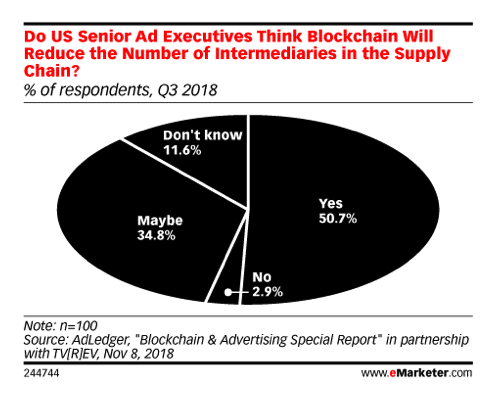Mobile Advertising Needs Blockchain

Being in mobile advertising is like skiing down a mountain as the snow melts: the landscape constantly changes and new challenges emerge every minute. Between recognizing fraud, optimizing spend, and trying to attribute every inch of your budget to metrics, marketers need to be extremely agile. I’m here to convince you that mobile advertising needs a blockchain standard, even if it doesn’t know it yet.
The denominator to most mobile marketing challenges is a lack of transparency across the full lifecycle of a campaign. Even with today’s nascent technology, blockchain can create smart contracts to manage attribution and payment as well as create a more transparent record of where and when your ads ran. For context, blockchain is the tech behind Bitcoin and was birthed in the financial sector. It refers to the use of distributed databases to maintain ‘blocks’ of records. The tech can be applied in scenarios where there is a transaction between two parties, like an ad buy, and all the data is stored in blocks which leave an audit trail that cannot be amended under the table. This E2E (end-to-end) audit trail adds security and transparency to every transaction it supports.
For an industry like mobile advertising, blockchain could be leveraged to make attribution more secure and indisputable. A few use cases that come to mind are:
- Increasing transparency by exposing sub sources. This would allow marketers to spot content patterns that would help inform where they put their spend to get the most efficiency.
- Verifying location-targeting by highlighting all VPN traffic that could be obscuring a user’s actual locale. Many marketers geo-target their ad spend but not all locations are truly verified.
- Ensuring contextual brand safety; this is tough in a world where sub sources are obscured. A whitelist approach does not necessarily ensure that your ads are shown in a the context that you would approve. Even if a source maps to your demographic you may not want your ads surfacing next to specific content. A blockchain based attribution system or delivery network would let brand marketers go in and see what environment and context their ads are living in for themselves.
- Tracking incrementality by letting BI teams easily access comprehensive audit trails that expose all of the advertising touch points a user has seen with detailed metadata like time and geo stamps. This type of audit capability could also help quantify the value of retargeting campaigns.
That said, implementing a blockchain-based solution for mobile advertising is not as easy at it sounds. Not only is the tech nascent but there are some compelling indications that the industry simply is not there yet:
- A version of this has already been attempted by Kochava. In 2017 they announced XCHNG, an open ledger blockchain framework for digital advertising. It enables the tokenization of an IO with infrastructure to facilitate buyer/seller transactions. It is still developing and is arguably the first step in a long journey. Although this is a move in the right direction, broader adoption and industry standardization would need to take root to see a massive impact made in 2019.
- Speed is a potential issue in using blockchain for UA verification. MMP transactions need to happen as close to real-time as possible. Current blockchain tech has certain redundancy factors that can impede speed; all transactions need to be digitally signed and verified using a key, every block in the network must reach a common consensus, etc.
- Not everyone enjoys this level of transparency: for publishers, having full visibility into your site IDs is optimal however for ad networks it means that they no longer have proprietary control over their sub sources. Full transparency will encourage more publishers to make direct deals with strong sources, cutting networks out of the transaction flow.
As companies continue to test blockchain solutions we will see transparency get prioritized, however it does little for initiatives like incrementality tracking or retargeting unless the entire industry is working to adopt the same standard. My prediction is that over time, as the landscape migrates towards a blockchain infrastructure, you can expect to see significant changes. Ad tech companies calling themselves DSPs, but who are actually leveraging another company’s DSP, are going to disappear when marketers see that their campaigns are being unnecessarily re-brokered. Even today sub sources are starting to reach out to advertisers to let them know their level of re-brokerage. As companies cut out the layers of middle men and costs decrease they will see ROAS gains. Additionally, many companies will need to modify their BI tools to be able to pull in and visualize this chain-based attribution. Blockchain APIs will allow savvy marketers to visualize their entire campaign lifecycles, traffic paths, time stamps, and cross-device identities allowing for machine learning analysis that is simply not possible today.

To continue in the right direction, the mobile marketing industry needs to continue to prioritize combating fraud, at conferences and in the office. Companies like Kochava need to continue to encourage the industry to adopt a programmatic blockchain transaction standard. Finally, as industry executives we need to ceaselessly educate ourselves on the emerging and anamorphic blockchain landscape. A 2018 eMarketer poll found that over 50% of ad executives think blockchain will make their advertising funnel more efficient, however another 2018 poll from Advertiser Perceptions noted that only 11% of marketers had ever completed a transaction using blockchain. We cannot expect the industry to change unless we immerse ourselves in new technology and push for the standard we want to see. Start lobbying your MMPs, DSPs, and affiliate partners. Revolutions are only thoughts until the product managers get involved.









